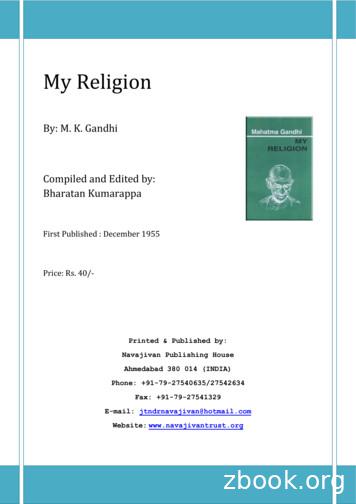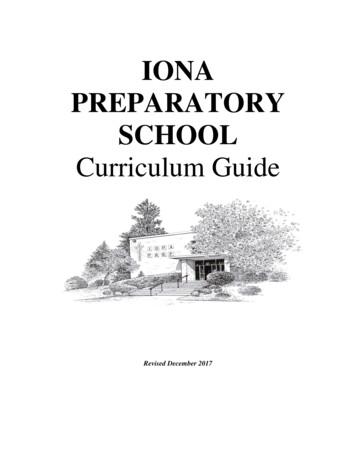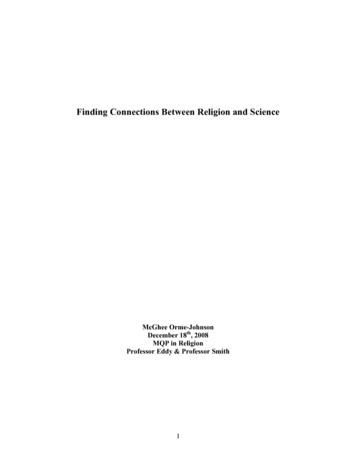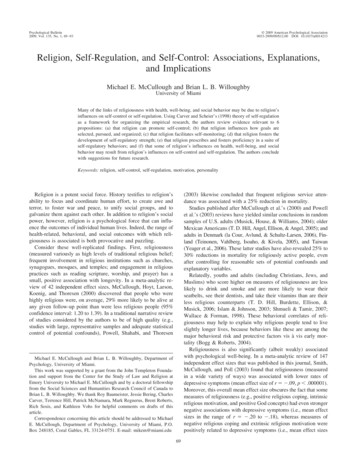RELIGION AND SOCIETY INTRODUCTION
RELIGION AND SOCIETYINTRODUCTION
Holistic The comparative study of human cultural diversity in all places andthroughout history.Looks at how humans organize theirlives as members of societies.Concerned with how humans maketheir lives meaningful as culturalindividuals.This necessitates historicaloverviews for comprehensiveunderstanding.More emphasis is placed ondiversity and individual case studiesthan on developing generalizations.
CULTURE A whole way of life. A system of meaningsembedded in symbols. The learned values,beliefs, and rules ofconduct shared to someextent by the membersof a society that governtheir behavior with oneanother.
CHARACTERISTICSOF CULTURE SharedTransmittedLearnedArbitraryTaken for grantedAlways changingAlways debatedAlways involvesrelations of power
SOCIETY People living in organized groups who share ageographical location, social institutions, andexpectations of behavior.
IDEAS ABOUT RELIGION YOUMIGHT HAVE HEARD BEFORE “Religion is the heart in a heartlessworld.” “Religion is the opiate of the masses.” “Science has killed religion.”
IS THERE A TRUE RELIGION?DOES GOD EXIST?DO ANGELS, DEMONS, OR GHOSTS EXIST?
* DEFINITION OF RELIGION: Any set ofbeliefs and practices involving the supernatural.* Many cultures do not make a sharp distinctionbetween the “natural” and the “supernatural.”ULURU,SACREDTO THEABORIGINALPEOPLES OFAUSTRALIA* PERSPECTIVES:* Holistic* Objective* Relativistic* Comparative* Interdisciplinary* Ethnographic* Methodologically and theoretically diverse
There are no “universal” standards bywhich all social and cultural groupscan be evaluated. No one religion is superior to another. People’s religious beliefs and practicesmust be studied within the frameworkof their own culture and history. All religions are equally meaningful totheir adherents. This is in contrast toETHNOCENTRISM: The conceptthat one’s own culture or religion issuperior to others and should be judgedfrom that perspective.
ANTHROPOLOGYSEEKS TO UNDERSTAND The range anddiversity of humanbeliefs and practices. What makes beliefsand practicesmeaningful to people. What the rolesreligion plays in theorganization ofcultures and societies.
From these perspectives we will investigate:Why religion is so widespread amongst human societies? The diversity of religions across cultures. Religion, gender, and sexuality. How religions contribute to the maintenance of socialorder. Religious beliefs and practices, and why they change. What part religions play in cultural and socialtransformation. The role of religions in transnationalism andglobalization.
Religions that are not tied to a particular culture orlocation. Colonialism, trade, missionaries, migration,etc., have spread world religions throughout the globe. There are many localized variations of the worldreligions, and vernacular or folk beliefs and practicesthat are closely connected to a specific culture orlocation. Buddhism Hinduism Islam Judaism Christianity
INDIGENOUSBELIEFS AND PRACTICES Many indigenousgroups havedistinct religioussystems of beliefsand practices inthe same way thatthey have theirown languagesand cultures.
RELIGIOUS SYNCRETISM Through time a culture’sreligious beliefs andpractices persist, but alsochange throughincorporating new elements. Religions are adopted andtransformed. FOR EXAMPLE: EarlyChristianity incorporatedEuropean paganism so that“Christ’s Mass” becameintegrated with pre Christiansymbols and practices.
They provide meaningin peoples’ lives. They help peoplemanage anxiety andincrease their sense ofpersonal order. They reinforce thesocial order. They instigate socialand cultural change.
RELIGIONS PROVIDE A“COSMOLOGY”A COSMOLOGY is a set of principles and/or beliefs about:– The nature of life and death.– How the universe was created.– The origin of society.– The relationship of individuals and groups to one another.– The relationship of humans to nature.
NAVAHO SAND PAINTINGWHEN A MEMBER OF THECOMMUNITY BECOMESILL OR ALIENATED ASHAMAN CREATES ASAND PAINTINGDEPICTING NAVAHOCOSMOLOGY. WITH THECOMMUNITYWITNESSING, THESHAMAN PERFORMS ACEREMONY, THE SANDPAINTING IS DESTROYED,AND THE DISTRESSEDMEMBER IS CURED ANDREINCORPORATED INTONAVAHO SOCIETY. THISREINFORCESSOLIDARITY FOR ALLINVOLVED.
CHARACTERISTICS OFRELIGION SACREDNARRATIVES SYMBOLS SPIRITS SACRED POWERS RITUALS ADDRESSING THESUPERNATURAL
SACRED NARRATIVES “Myths” that recount historical events, heroes, gods, spirits, and theorigin of all things. Anthropology defines “myth” as realities lived and stories told. Sacred narratives are integral to a society’s rituals, moral code, andorganization.
RELIGIOUS SYMBOLS
SPIRITS Most religions assert the worldis filled with beings and powersthat have life and consciousnessseparate from humans’, butwhose existence cannot bescientifically validated. GOD: A spirit that is believed tohave created the world, or whoexerts control over the world. TRICKSTER: A spirit that doesnot always act in the bestinterest of humans.
SACRED POWERS MANA: A special kindof sacred power or energythat infuses the universe. Mana can be concentratedin humans, othercreatures, spirits, andobjects. Integral to many differentreligions across cultures.
RITUALS Rituals are ceremonialacts with repeated,stylized gestures thatmanipulate religioussymbols for specificpurposes. People enact andreinforce their religiousbeliefs through theseritualized practices.
COMMUNING WITH THESUPERNATURAL The majority of ritualsare designed tocommune with and/orcontrol supernaturalspirits and powersthrough a combinationof:– PRAYER– SACRIFICE– MAGIC
RELIGIOUS PRACTITIONERS SHAMAN: An averagemember of a communitywho is sociallyrecognized as having theability to mediatebetween humans andspirits. PRIEST: A person whois formally elected,appointed, or hired to afull-time religious office.
WITCHCRAFT AND SORCERY Witchcraft and sorcery are verycommon elements of religious beliefsand practices in many cultures. Based in earlier anthropologists’research among “non Western”cultures: WITCHCRAFT is The ability to harm others byharboring malevolent thoughts aboutthem. SORCERY is the conscious andintentional use of magic. Witchcraft based in “Western” culturesis the intentional use of magic to aid orharm others, society, and theenvironment, and thus comparable tosorcery.AZANDEOF AFRICA
MAGIC Belief that supernaturalpowers can be influencedthrough the use of ritualformulas.– Sympathetic magic usesrepresentational objects,such as dolls.– Contagious magic is adirect relationship betweenritual and the body, suchas use of the subject’s hairor fingernails.
Why religion is so widespread amongst human societies? The diversity of religions across cultures. Religion, gender, and sexuality. How religions contribute to the maintenance of social order. Religious beliefs and practices, and why they change. What p
FAMILY AND RELIGIOUS STUDIES SYLLABUS (FORMS 1 – 4) 9 Religion and the Liberation Struggle-Chimurenga/Umvukela Religion, Rights and Social Responsibility Religion and Conflict management 7.0 SCOPE AND SEQUENCE 7.1 TOPIC 1: RELIGION SUB-TOPIC FOR M 1 FORM 2 FORM 3 FORM 4 Concept of Religion Definition, types and c haracteristics of religion Different religions in Zimbabwe .
religion. However, religion cannot be defined except by the characteristics by which are found wherever religion itself is found.4 Nevertheless, the one aspect of religion that must be agreed upon, and is required to remotely be considered as religion, is that it is a belief system held by a group of
Religion which takes no account of practical affairs and does not help to solve them, is no religion. Young India, 7-5-'25, p. 164 Every activity of a man of religion must be derived from his religion, because religion means being bound to God,
Religion in the Schools Task Force guided this initiative.6 Overview of Guidelines Part One addresses why it is important to teach about religion, and Part Two outlines ways to teach about religion in constitutionally sound ways. Part Three is an overview of approaches to teaching about religion
Curriculum Guide Revised December 2017. Course Offerings Department 9th 10th 11th 12th Religion Religion 1 Religion 2 Religion 3 Religion 4 Religion 4/ Leadership . Freshmen will become familiar with the Common Application to understand the elements considered by colleges for admission.
Approved Themes: Religion and Society, Religion and Gender, Religion and the Arts, and Philosophy of Religion. It may also be possible to substitute other themes, again depending on faculty and course offerings. At the beginning of each semest
Religion and science serve different purposes to different people. As such, Latour’s view is only one way of describing the purposes of religion and science, and there could be other views that allow for more of a compliment between religion and science. I would suggest that religion and science have different purposes than what
Keywords: religion, self-control, self-regulation, motivation, personality Religion is a potent social force. History testifies to religion s ability to focus and coordinate human effort, to create awe and terror, to foster war and peace, to unify social groups, and to galvanize them against each other. In addition to religion s social























